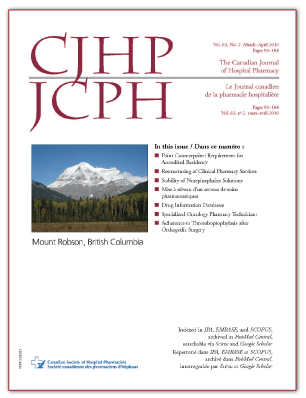Stability of Norepinephrine Solutions in Normal Saline and 5% Dextrose in Water
DOI:
https://doi.org/10.4212/cjhp.v63i2.896Keywords:
norepinephrine, drug stability, norépinéphrine, stabilité des médicamentsAbstract
ABSTRACT
Background: Most previous stability studies for norepinephrine have reported the percentage of drug remaining in IV solutions after only 24 h. No previously published study has evaluated the effect of light on the stability of this drug.
Objective: To evaluate the stability of norepinephrine (64 mg/L) in either normal saline (NS; 0.9% sodium chloride) or 5% dextrose in water (D5W) with storage at either 4°C or room temperature (23°C) in polyvinyl chloride (PVC) bags exposed to or protected from normal room lighting for 2 months.
Methods: Thirty-two PVC bags were prepared, each containing norepinephrine at 64 mg/L; half of the bags had normal saline as the diluent and the other half had D5W. The bags were stored at either 4°C or room temperature (23°C), with protection from or exposure to ambient fluorescent room light. Overall, there were 4 bags for each combination of diluent, temperature, and light condition. The concentration of norepinephrine in each bag was determined by a validated, stability-indicating liquid chromatographic method on study days 0, 1, 2, 3, 4, 8, 9, 10, 11, 14, 18, 21, 23, 25, 28, 30, 36, 42, and 61.
Results: Analysis of variance revealed differences in percentage remaining as a function of study day (p < 0.001) and light conditions (p < 0.001), but not diluent (p = 0.06) or storage temperature (p > 0.99).
Conclusions: Solutions of norepinephrine 64 mg/L in NS or D5W can be stored in PVC bags at 4°C for up to 61 days with protection from light. This expiry date allows for up to 24 h storage at 23°C. Solutions that are not protected from light will retain only 90% of the initial concentration after storage for 39 days at 4°C. This storage period could include up to 24 h at room temperature, without protection from light.
RÉSUMÉ
Contexte : La majorité des études antérieures sur la stabilité de la norépinéphrine ont rendu compte du pourcentage de médicament résiduel dans les solutions intraveineuses après seulement 24 heures. Aucune étude publiée précédemment n’a évalué l’effet de la lumière sur la stabilité de ce médicament.
Objectif : Évaluer la stabilité de la norépinéphrine (64 mg/L) préparée dans une solution physiologique salée (SP; chlorure de sodium à 0,9 %) ou du dextrose à 5 % dans l’eau (D5E) et conservée à 4 °C ou à la température ambiante (23 °C) dans des sacs de polychlorure de vinyle (PVC) exposés ou protégés de la lumière ambiante normale pendant deux mois.
Méthodes : Trente-deux sacs de PVC ont été préparés, chacun contenant de la norépinéphrine à 64 mg/L, la moitié en utilisant comme diluant de la SP et l’autre moitié, du D5E,. Les sacs ont été entreposés soit à 4 °C, soit à la température ambiante (23 °C), protégés de la lumière ou exposés à l’éclairage fluorescent ambiant. Dans l’ensemble, quatre sacs ont été préparés pour chaque combinaison de diluant, de température et de condition d’éclairage. La concentration de norépinéphrine dans chaque sac a été déterminée à l’aide d’une épreuve validée par chromatographie liquide haute performance mesurant la stabilité aux jours 0, 1, 2, 3, 4, 8, 9, 10, 11, 14, 18, 21, 23, 25, 28, 30, 36, 42 et 61 de l’étude.
Résultats : Une analyse de variance a révélé des différences dans le pourcentage de médicament résiduel, en fonction du jour de l’étude (p < 0,001) et des conditions d’éclairage (p < 0,001), mais non en fonction du diluant (p = 0,06) ou de la température d’entreposage (p > 0,99).
Conclusions : Les solutions de norépinéphrine à 64 mg/L préparées dans de la SP ou du D5E et conservées dans des sacs de PVC peuvent être entreposées à une température de 4 °C pendant un maximum de 61 jours, protégées de la lumière. Cette durée de conservation permet un entreposage pendant un maximum de 24 heures à une température de 23 °C. Les solutions non protégées de la lumière ne conserveront que 90 % de la concentration initiale de médicament après avoir été entreposées pendant 39 jours à 4 °C. Cette période d’entreposage peut comprendre un maximum de 24 heures à la température ambiante et non à l’abri de la lumière.
Downloads
Downloads
Issue
Section
License
Copyright © Canadian Society of Healthcare-Systems Pharmacy.
After publication of a manuscript in the CJHP, the authors of the manuscript must obtain written permission from the CSHP (publications@cshp.ca) before reproducing any text, figures, tables, or illustrations from the work in future works of their own. If a submitted manuscript is declined for publication in the CJHP, all said rights shall revert to the authors. Please note that any forms (e.g., preprinted orders and patient intake forms) used by a specific hospital or other health care facility and included as illustrative material with a manuscript are exempt from this copyright transfer. The CJHP will require a letter from the hospital or health care facility granting permission to publish the document(s).










